Global Supply Chain Management Practices
VerifiedAdded on 2020/05/28
|12
|2491
|69
AI Summary
This assignment focuses on developing a comprehensive approach to global supply chain management. It requires students to research and understand best practices for sourcing information from external sources, purchasing from foreign suppliers, and managing export activities. The emphasis is on creating a systematic framework that fosters innovation and skill development in these areas.
Contribute Materials
Your contribution can guide someone’s learning journey. Share your
documents today.
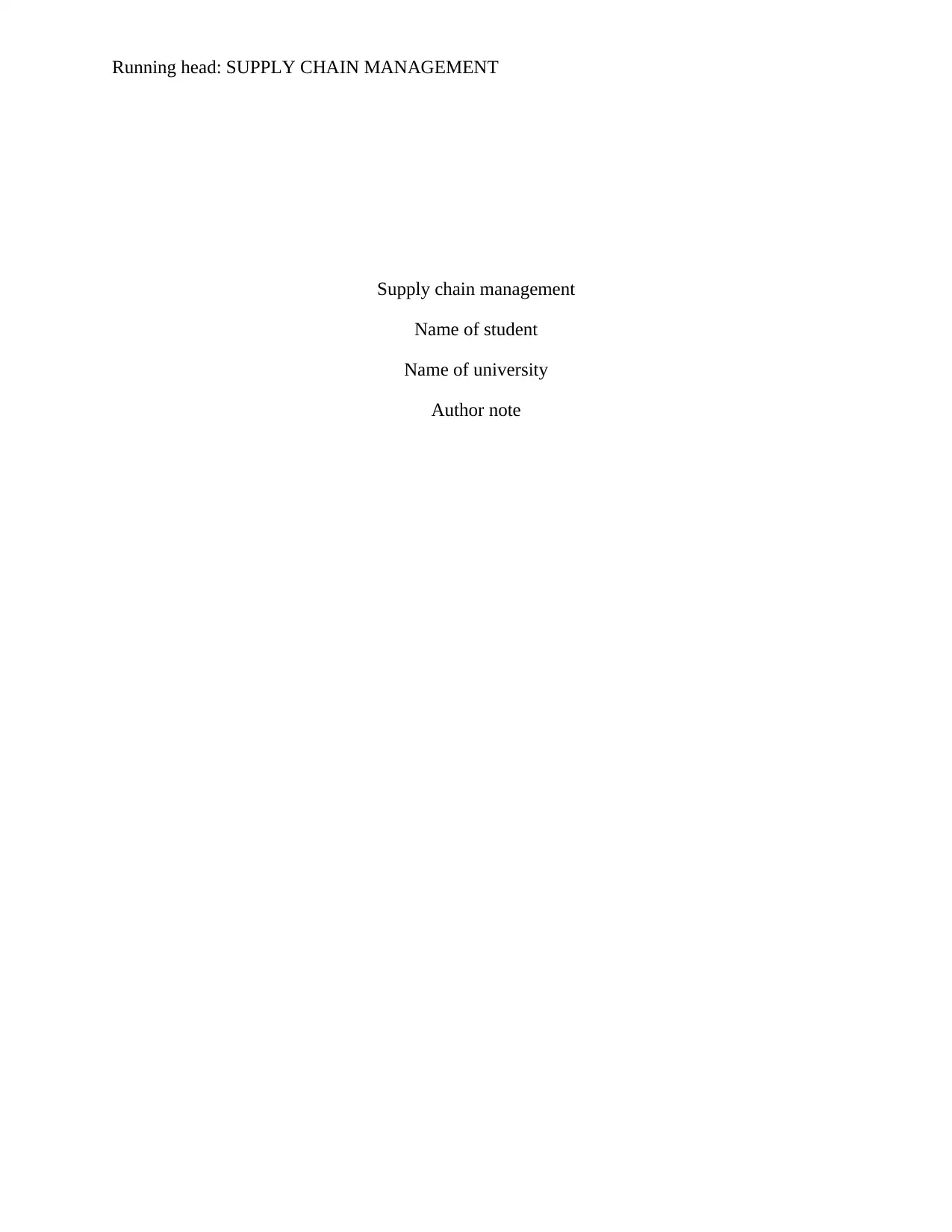
Running head: SUPPLY CHAIN MANAGEMENT
Supply chain management
Name of student
Name of university
Author note
Supply chain management
Name of student
Name of university
Author note
Secure Best Marks with AI Grader
Need help grading? Try our AI Grader for instant feedback on your assignments.
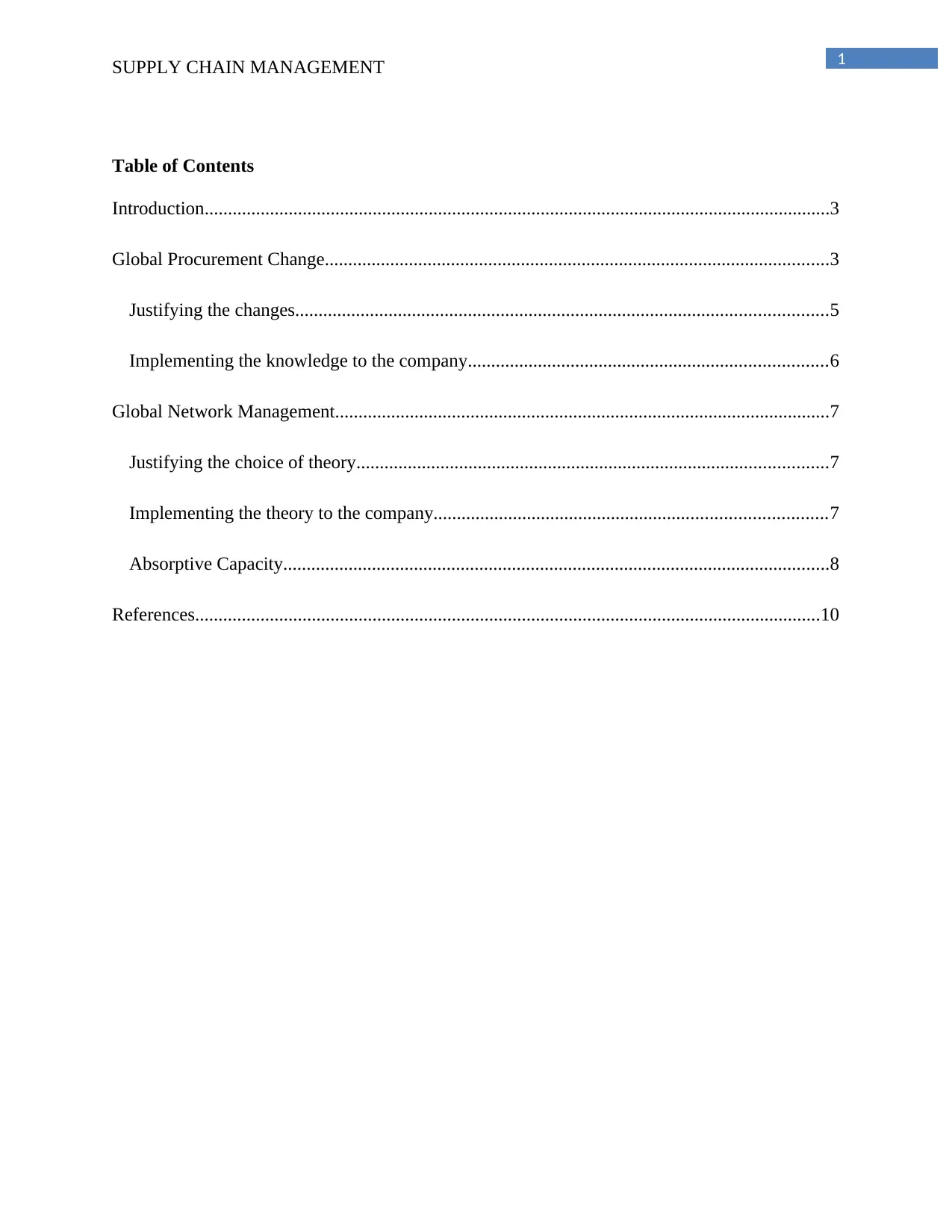
1SUPPLY CHAIN MANAGEMENT
Table of Contents
Introduction......................................................................................................................................3
Global Procurement Change............................................................................................................3
Justifying the changes..................................................................................................................5
Implementing the knowledge to the company.............................................................................6
Global Network Management..........................................................................................................7
Justifying the choice of theory.....................................................................................................7
Implementing the theory to the company....................................................................................7
Absorptive Capacity.....................................................................................................................8
References......................................................................................................................................10
Table of Contents
Introduction......................................................................................................................................3
Global Procurement Change............................................................................................................3
Justifying the changes..................................................................................................................5
Implementing the knowledge to the company.............................................................................6
Global Network Management..........................................................................................................7
Justifying the choice of theory.....................................................................................................7
Implementing the theory to the company....................................................................................7
Absorptive Capacity.....................................................................................................................8
References......................................................................................................................................10
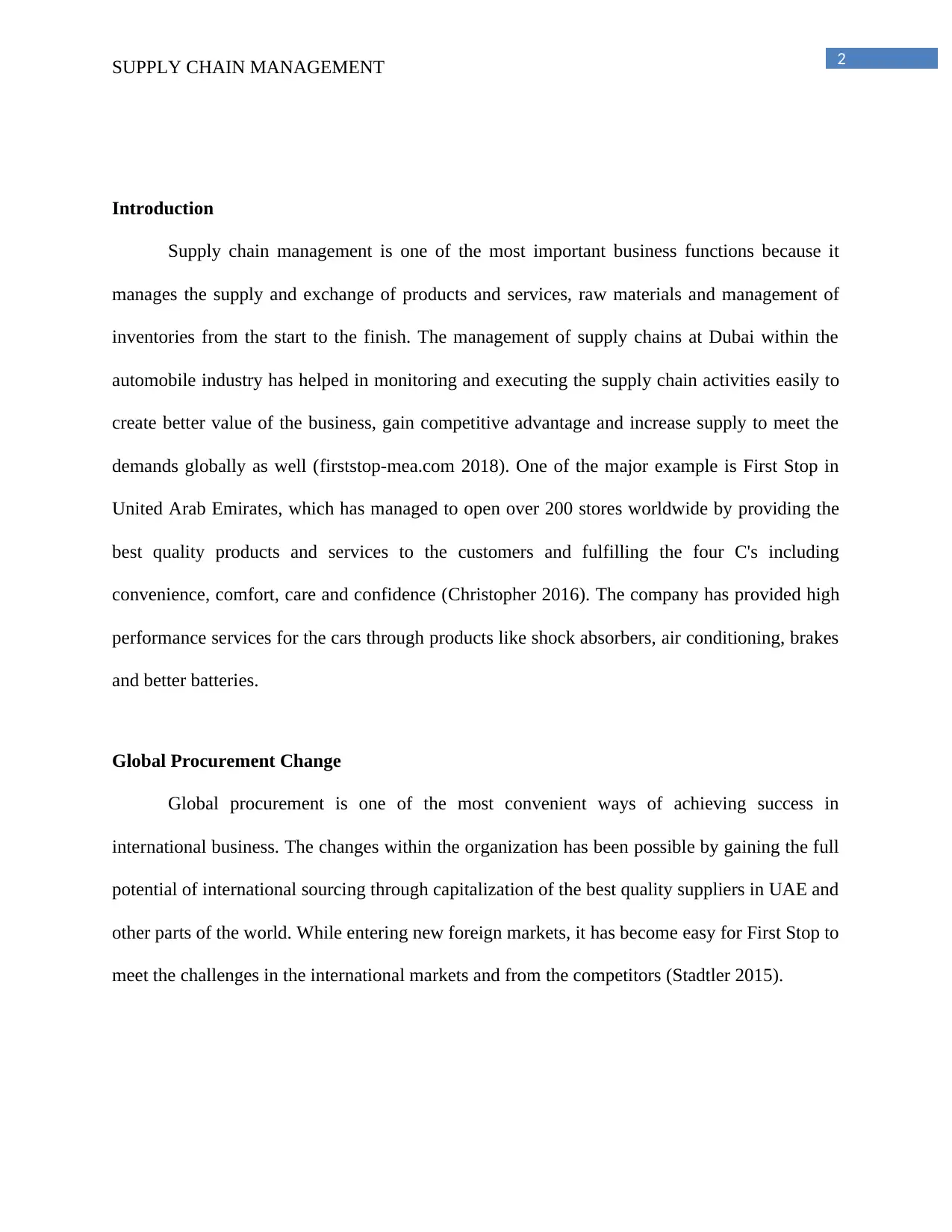
2SUPPLY CHAIN MANAGEMENT
Introduction
Supply chain management is one of the most important business functions because it
manages the supply and exchange of products and services, raw materials and management of
inventories from the start to the finish. The management of supply chains at Dubai within the
automobile industry has helped in monitoring and executing the supply chain activities easily to
create better value of the business, gain competitive advantage and increase supply to meet the
demands globally as well (firststop-mea.com 2018). One of the major example is First Stop in
United Arab Emirates, which has managed to open over 200 stores worldwide by providing the
best quality products and services to the customers and fulfilling the four C's including
convenience, comfort, care and confidence (Christopher 2016). The company has provided high
performance services for the cars through products like shock absorbers, air conditioning, brakes
and better batteries.
Global Procurement Change
Global procurement is one of the most convenient ways of achieving success in
international business. The changes within the organization has been possible by gaining the full
potential of international sourcing through capitalization of the best quality suppliers in UAE and
other parts of the world. While entering new foreign markets, it has become easy for First Stop to
meet the challenges in the international markets and from the competitors (Stadtler 2015).
Introduction
Supply chain management is one of the most important business functions because it
manages the supply and exchange of products and services, raw materials and management of
inventories from the start to the finish. The management of supply chains at Dubai within the
automobile industry has helped in monitoring and executing the supply chain activities easily to
create better value of the business, gain competitive advantage and increase supply to meet the
demands globally as well (firststop-mea.com 2018). One of the major example is First Stop in
United Arab Emirates, which has managed to open over 200 stores worldwide by providing the
best quality products and services to the customers and fulfilling the four C's including
convenience, comfort, care and confidence (Christopher 2016). The company has provided high
performance services for the cars through products like shock absorbers, air conditioning, brakes
and better batteries.
Global Procurement Change
Global procurement is one of the most convenient ways of achieving success in
international business. The changes within the organization has been possible by gaining the full
potential of international sourcing through capitalization of the best quality suppliers in UAE and
other parts of the world. While entering new foreign markets, it has become easy for First Stop to
meet the challenges in the international markets and from the competitors (Stadtler 2015).
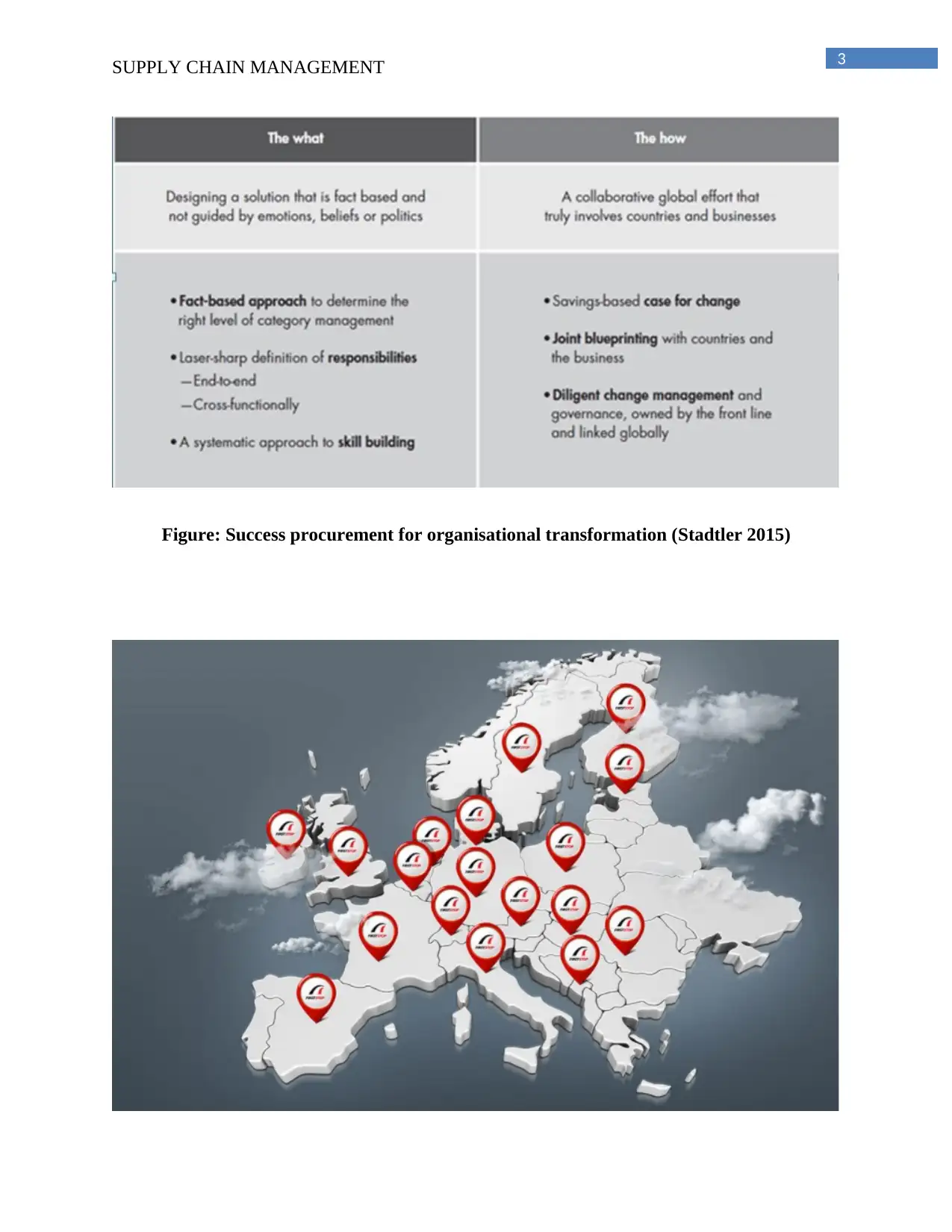
3SUPPLY CHAIN MANAGEMENT
Figure: Success procurement for organisational transformation (Stadtler 2015)
Figure: Success procurement for organisational transformation (Stadtler 2015)
Secure Best Marks with AI Grader
Need help grading? Try our AI Grader for instant feedback on your assignments.
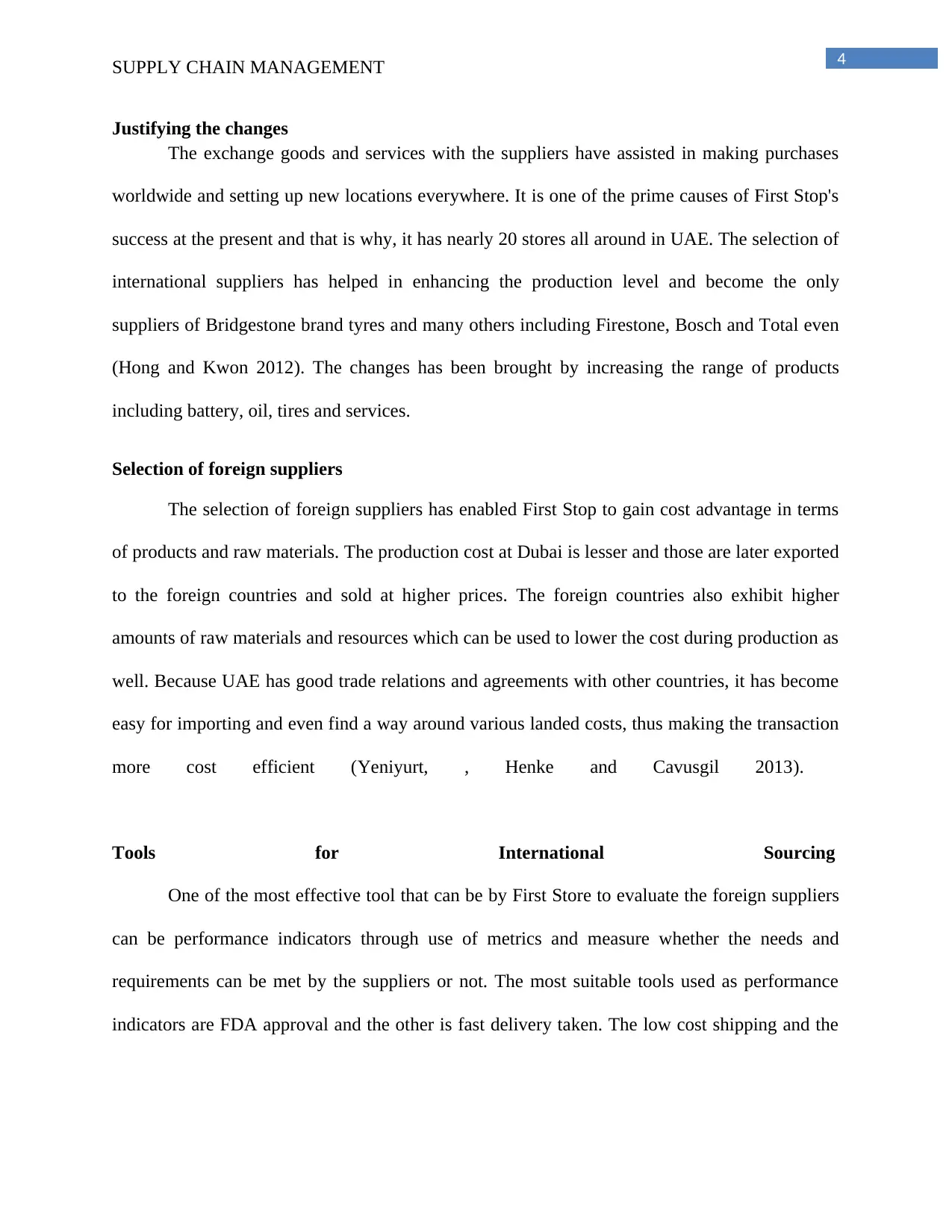
4SUPPLY CHAIN MANAGEMENT
Justifying the changes
The exchange goods and services with the suppliers have assisted in making purchases
worldwide and setting up new locations everywhere. It is one of the prime causes of First Stop's
success at the present and that is why, it has nearly 20 stores all around in UAE. The selection of
international suppliers has helped in enhancing the production level and become the only
suppliers of Bridgestone brand tyres and many others including Firestone, Bosch and Total even
(Hong and Kwon 2012). The changes has been brought by increasing the range of products
including battery, oil, tires and services.
Selection of foreign suppliers
The selection of foreign suppliers has enabled First Stop to gain cost advantage in terms
of products and raw materials. The production cost at Dubai is lesser and those are later exported
to the foreign countries and sold at higher prices. The foreign countries also exhibit higher
amounts of raw materials and resources which can be used to lower the cost during production as
well. Because UAE has good trade relations and agreements with other countries, it has become
easy for importing and even find a way around various landed costs, thus making the transaction
more cost efficient (Yeniyurt, , Henke and Cavusgil 2013).
Tools for International Sourcing
One of the most effective tool that can be by First Store to evaluate the foreign suppliers
can be performance indicators through use of metrics and measure whether the needs and
requirements can be met by the suppliers or not. The most suitable tools used as performance
indicators are FDA approval and the other is fast delivery taken. The low cost shipping and the
Justifying the changes
The exchange goods and services with the suppliers have assisted in making purchases
worldwide and setting up new locations everywhere. It is one of the prime causes of First Stop's
success at the present and that is why, it has nearly 20 stores all around in UAE. The selection of
international suppliers has helped in enhancing the production level and become the only
suppliers of Bridgestone brand tyres and many others including Firestone, Bosch and Total even
(Hong and Kwon 2012). The changes has been brought by increasing the range of products
including battery, oil, tires and services.
Selection of foreign suppliers
The selection of foreign suppliers has enabled First Stop to gain cost advantage in terms
of products and raw materials. The production cost at Dubai is lesser and those are later exported
to the foreign countries and sold at higher prices. The foreign countries also exhibit higher
amounts of raw materials and resources which can be used to lower the cost during production as
well. Because UAE has good trade relations and agreements with other countries, it has become
easy for importing and even find a way around various landed costs, thus making the transaction
more cost efficient (Yeniyurt, , Henke and Cavusgil 2013).
Tools for International Sourcing
One of the most effective tool that can be by First Store to evaluate the foreign suppliers
can be performance indicators through use of metrics and measure whether the needs and
requirements can be met by the suppliers or not. The most suitable tools used as performance
indicators are FDA approval and the other is fast delivery taken. The low cost shipping and the
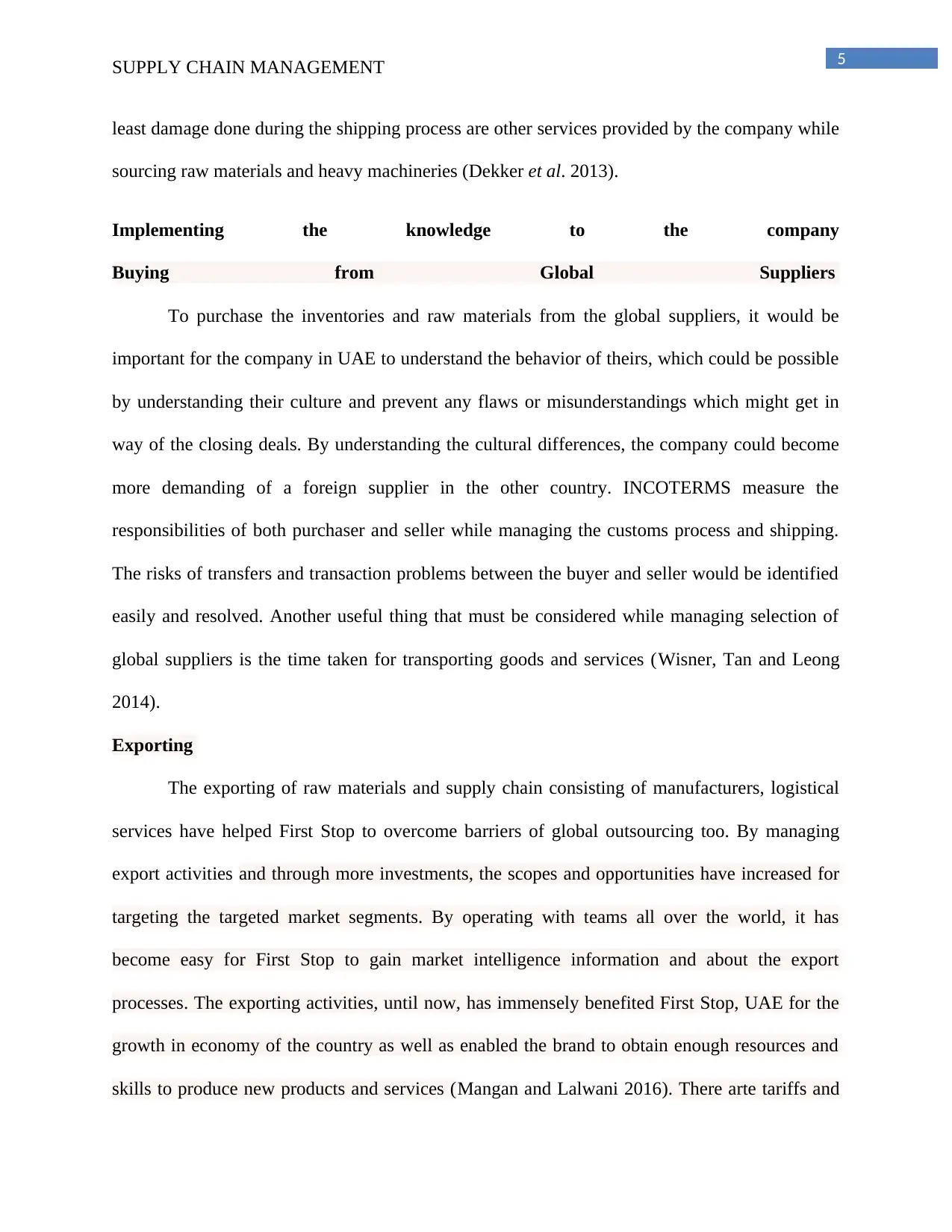
5SUPPLY CHAIN MANAGEMENT
least damage done during the shipping process are other services provided by the company while
sourcing raw materials and heavy machineries (Dekker et al. 2013).
Implementing the knowledge to the company
Buying from Global Suppliers
To purchase the inventories and raw materials from the global suppliers, it would be
important for the company in UAE to understand the behavior of theirs, which could be possible
by understanding their culture and prevent any flaws or misunderstandings which might get in
way of the closing deals. By understanding the cultural differences, the company could become
more demanding of a foreign supplier in the other country. INCOTERMS measure the
responsibilities of both purchaser and seller while managing the customs process and shipping.
The risks of transfers and transaction problems between the buyer and seller would be identified
easily and resolved. Another useful thing that must be considered while managing selection of
global suppliers is the time taken for transporting goods and services (Wisner, Tan and Leong
2014).
Exporting
The exporting of raw materials and supply chain consisting of manufacturers, logistical
services have helped First Stop to overcome barriers of global outsourcing too. By managing
export activities and through more investments, the scopes and opportunities have increased for
targeting the targeted market segments. By operating with teams all over the world, it has
become easy for First Stop to gain market intelligence information and about the export
processes. The exporting activities, until now, has immensely benefited First Stop, UAE for the
growth in economy of the country as well as enabled the brand to obtain enough resources and
skills to produce new products and services (Mangan and Lalwani 2016). There arte tariffs and
least damage done during the shipping process are other services provided by the company while
sourcing raw materials and heavy machineries (Dekker et al. 2013).
Implementing the knowledge to the company
Buying from Global Suppliers
To purchase the inventories and raw materials from the global suppliers, it would be
important for the company in UAE to understand the behavior of theirs, which could be possible
by understanding their culture and prevent any flaws or misunderstandings which might get in
way of the closing deals. By understanding the cultural differences, the company could become
more demanding of a foreign supplier in the other country. INCOTERMS measure the
responsibilities of both purchaser and seller while managing the customs process and shipping.
The risks of transfers and transaction problems between the buyer and seller would be identified
easily and resolved. Another useful thing that must be considered while managing selection of
global suppliers is the time taken for transporting goods and services (Wisner, Tan and Leong
2014).
Exporting
The exporting of raw materials and supply chain consisting of manufacturers, logistical
services have helped First Stop to overcome barriers of global outsourcing too. By managing
export activities and through more investments, the scopes and opportunities have increased for
targeting the targeted market segments. By operating with teams all over the world, it has
become easy for First Stop to gain market intelligence information and about the export
processes. The exporting activities, until now, has immensely benefited First Stop, UAE for the
growth in economy of the country as well as enabled the brand to obtain enough resources and
skills to produce new products and services (Mangan and Lalwani 2016). There arte tariffs and
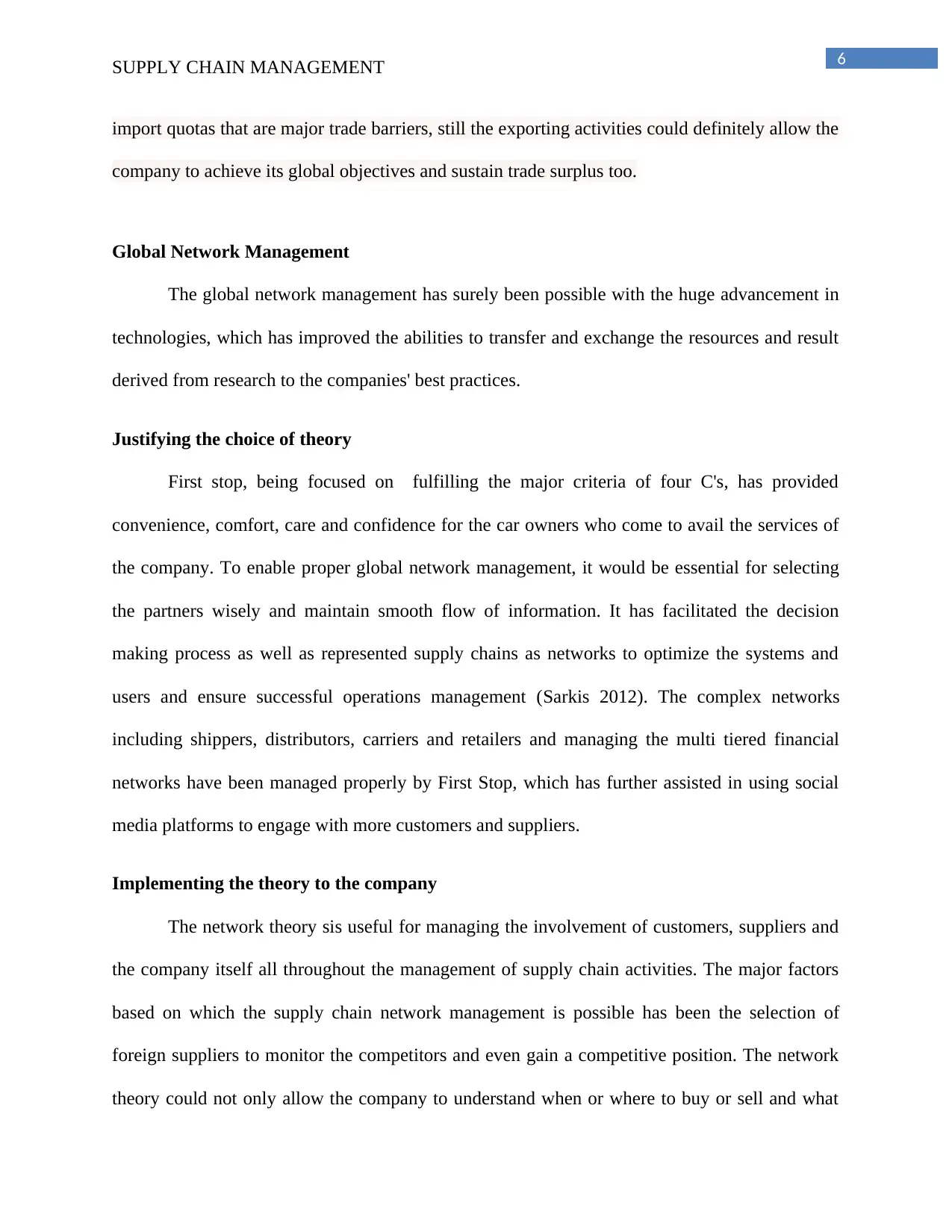
6SUPPLY CHAIN MANAGEMENT
import quotas that are major trade barriers, still the exporting activities could definitely allow the
company to achieve its global objectives and sustain trade surplus too.
Global Network Management
The global network management has surely been possible with the huge advancement in
technologies, which has improved the abilities to transfer and exchange the resources and result
derived from research to the companies' best practices.
Justifying the choice of theory
First stop, being focused on fulfilling the major criteria of four C's, has provided
convenience, comfort, care and confidence for the car owners who come to avail the services of
the company. To enable proper global network management, it would be essential for selecting
the partners wisely and maintain smooth flow of information. It has facilitated the decision
making process as well as represented supply chains as networks to optimize the systems and
users and ensure successful operations management (Sarkis 2012). The complex networks
including shippers, distributors, carriers and retailers and managing the multi tiered financial
networks have been managed properly by First Stop, which has further assisted in using social
media platforms to engage with more customers and suppliers.
Implementing the theory to the company
The network theory sis useful for managing the involvement of customers, suppliers and
the company itself all throughout the management of supply chain activities. The major factors
based on which the supply chain network management is possible has been the selection of
foreign suppliers to monitor the competitors and even gain a competitive position. The network
theory could not only allow the company to understand when or where to buy or sell and what
import quotas that are major trade barriers, still the exporting activities could definitely allow the
company to achieve its global objectives and sustain trade surplus too.
Global Network Management
The global network management has surely been possible with the huge advancement in
technologies, which has improved the abilities to transfer and exchange the resources and result
derived from research to the companies' best practices.
Justifying the choice of theory
First stop, being focused on fulfilling the major criteria of four C's, has provided
convenience, comfort, care and confidence for the car owners who come to avail the services of
the company. To enable proper global network management, it would be essential for selecting
the partners wisely and maintain smooth flow of information. It has facilitated the decision
making process as well as represented supply chains as networks to optimize the systems and
users and ensure successful operations management (Sarkis 2012). The complex networks
including shippers, distributors, carriers and retailers and managing the multi tiered financial
networks have been managed properly by First Stop, which has further assisted in using social
media platforms to engage with more customers and suppliers.
Implementing the theory to the company
The network theory sis useful for managing the involvement of customers, suppliers and
the company itself all throughout the management of supply chain activities. The major factors
based on which the supply chain network management is possible has been the selection of
foreign suppliers to monitor the competitors and even gain a competitive position. The network
theory could not only allow the company to understand when or where to buy or sell and what
Paraphrase This Document
Need a fresh take? Get an instant paraphrase of this document with our AI Paraphraser
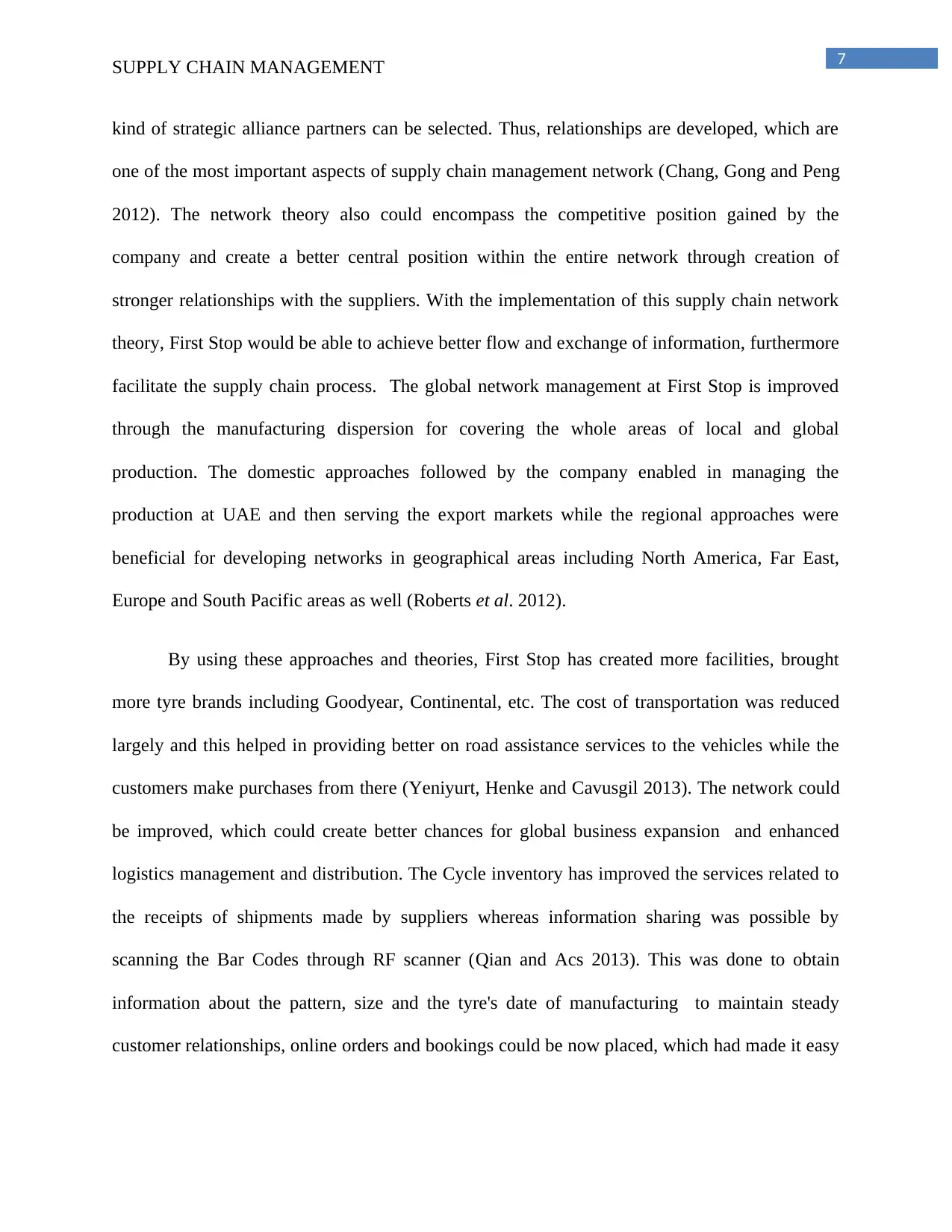
7SUPPLY CHAIN MANAGEMENT
kind of strategic alliance partners can be selected. Thus, relationships are developed, which are
one of the most important aspects of supply chain management network (Chang, Gong and Peng
2012). The network theory also could encompass the competitive position gained by the
company and create a better central position within the entire network through creation of
stronger relationships with the suppliers. With the implementation of this supply chain network
theory, First Stop would be able to achieve better flow and exchange of information, furthermore
facilitate the supply chain process. The global network management at First Stop is improved
through the manufacturing dispersion for covering the whole areas of local and global
production. The domestic approaches followed by the company enabled in managing the
production at UAE and then serving the export markets while the regional approaches were
beneficial for developing networks in geographical areas including North America, Far East,
Europe and South Pacific areas as well (Roberts et al. 2012).
By using these approaches and theories, First Stop has created more facilities, brought
more tyre brands including Goodyear, Continental, etc. The cost of transportation was reduced
largely and this helped in providing better on road assistance services to the vehicles while the
customers make purchases from there (Yeniyurt, Henke and Cavusgil 2013). The network could
be improved, which could create better chances for global business expansion and enhanced
logistics management and distribution. The Cycle inventory has improved the services related to
the receipts of shipments made by suppliers whereas information sharing was possible by
scanning the Bar Codes through RF scanner (Qian and Acs 2013). This was done to obtain
information about the pattern, size and the tyre's date of manufacturing to maintain steady
customer relationships, online orders and bookings could be now placed, which had made it easy
kind of strategic alliance partners can be selected. Thus, relationships are developed, which are
one of the most important aspects of supply chain management network (Chang, Gong and Peng
2012). The network theory also could encompass the competitive position gained by the
company and create a better central position within the entire network through creation of
stronger relationships with the suppliers. With the implementation of this supply chain network
theory, First Stop would be able to achieve better flow and exchange of information, furthermore
facilitate the supply chain process. The global network management at First Stop is improved
through the manufacturing dispersion for covering the whole areas of local and global
production. The domestic approaches followed by the company enabled in managing the
production at UAE and then serving the export markets while the regional approaches were
beneficial for developing networks in geographical areas including North America, Far East,
Europe and South Pacific areas as well (Roberts et al. 2012).
By using these approaches and theories, First Stop has created more facilities, brought
more tyre brands including Goodyear, Continental, etc. The cost of transportation was reduced
largely and this helped in providing better on road assistance services to the vehicles while the
customers make purchases from there (Yeniyurt, Henke and Cavusgil 2013). The network could
be improved, which could create better chances for global business expansion and enhanced
logistics management and distribution. The Cycle inventory has improved the services related to
the receipts of shipments made by suppliers whereas information sharing was possible by
scanning the Bar Codes through RF scanner (Qian and Acs 2013). This was done to obtain
information about the pattern, size and the tyre's date of manufacturing to maintain steady
customer relationships, online orders and bookings could be now placed, which had made it easy
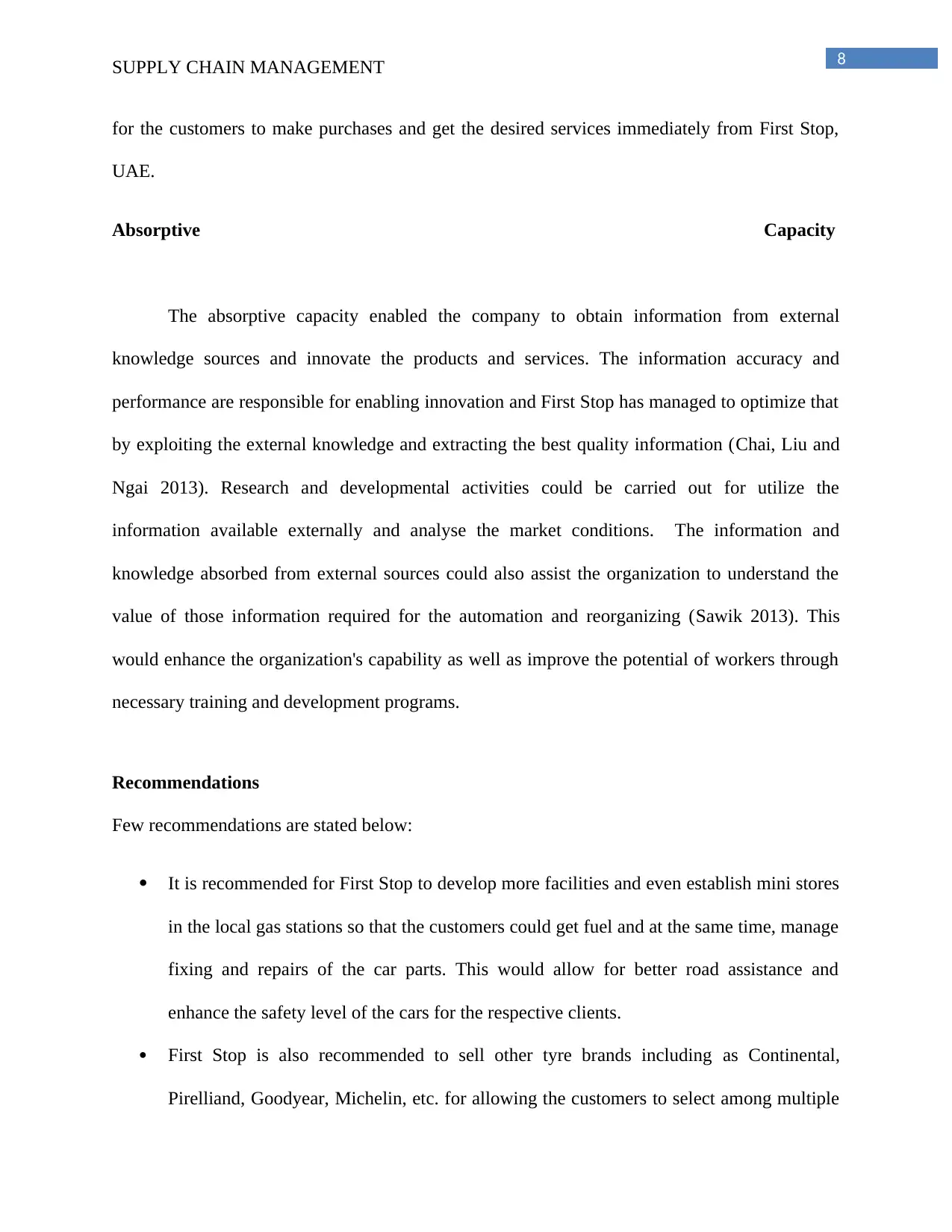
8SUPPLY CHAIN MANAGEMENT
for the customers to make purchases and get the desired services immediately from First Stop,
UAE.
Absorptive Capacity
The absorptive capacity enabled the company to obtain information from external
knowledge sources and innovate the products and services. The information accuracy and
performance are responsible for enabling innovation and First Stop has managed to optimize that
by exploiting the external knowledge and extracting the best quality information (Chai, Liu and
Ngai 2013). Research and developmental activities could be carried out for utilize the
information available externally and analyse the market conditions. The information and
knowledge absorbed from external sources could also assist the organization to understand the
value of those information required for the automation and reorganizing (Sawik 2013). This
would enhance the organization's capability as well as improve the potential of workers through
necessary training and development programs.
Recommendations
Few recommendations are stated below:
It is recommended for First Stop to develop more facilities and even establish mini stores
in the local gas stations so that the customers could get fuel and at the same time, manage
fixing and repairs of the car parts. This would allow for better road assistance and
enhance the safety level of the cars for the respective clients.
First Stop is also recommended to sell other tyre brands including as Continental,
Pirelliand, Goodyear, Michelin, etc. for allowing the customers to select among multiple
for the customers to make purchases and get the desired services immediately from First Stop,
UAE.
Absorptive Capacity
The absorptive capacity enabled the company to obtain information from external
knowledge sources and innovate the products and services. The information accuracy and
performance are responsible for enabling innovation and First Stop has managed to optimize that
by exploiting the external knowledge and extracting the best quality information (Chai, Liu and
Ngai 2013). Research and developmental activities could be carried out for utilize the
information available externally and analyse the market conditions. The information and
knowledge absorbed from external sources could also assist the organization to understand the
value of those information required for the automation and reorganizing (Sawik 2013). This
would enhance the organization's capability as well as improve the potential of workers through
necessary training and development programs.
Recommendations
Few recommendations are stated below:
It is recommended for First Stop to develop more facilities and even establish mini stores
in the local gas stations so that the customers could get fuel and at the same time, manage
fixing and repairs of the car parts. This would allow for better road assistance and
enhance the safety level of the cars for the respective clients.
First Stop is also recommended to sell other tyre brands including as Continental,
Pirelliand, Goodyear, Michelin, etc. for allowing the customers to select among multiple
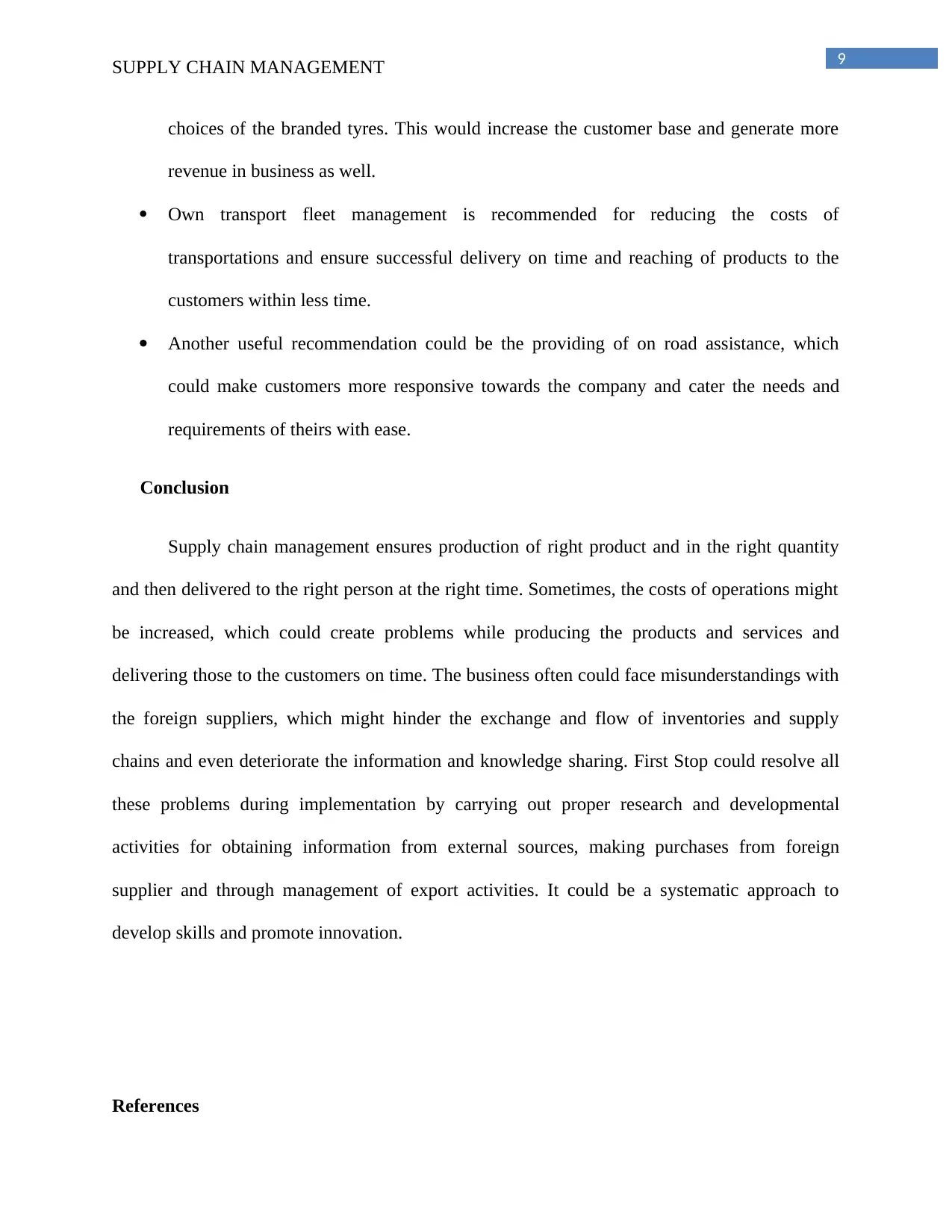
9SUPPLY CHAIN MANAGEMENT
choices of the branded tyres. This would increase the customer base and generate more
revenue in business as well.
Own transport fleet management is recommended for reducing the costs of
transportations and ensure successful delivery on time and reaching of products to the
customers within less time.
Another useful recommendation could be the providing of on road assistance, which
could make customers more responsive towards the company and cater the needs and
requirements of theirs with ease.
Conclusion
Supply chain management ensures production of right product and in the right quantity
and then delivered to the right person at the right time. Sometimes, the costs of operations might
be increased, which could create problems while producing the products and services and
delivering those to the customers on time. The business often could face misunderstandings with
the foreign suppliers, which might hinder the exchange and flow of inventories and supply
chains and even deteriorate the information and knowledge sharing. First Stop could resolve all
these problems during implementation by carrying out proper research and developmental
activities for obtaining information from external sources, making purchases from foreign
supplier and through management of export activities. It could be a systematic approach to
develop skills and promote innovation.
References
choices of the branded tyres. This would increase the customer base and generate more
revenue in business as well.
Own transport fleet management is recommended for reducing the costs of
transportations and ensure successful delivery on time and reaching of products to the
customers within less time.
Another useful recommendation could be the providing of on road assistance, which
could make customers more responsive towards the company and cater the needs and
requirements of theirs with ease.
Conclusion
Supply chain management ensures production of right product and in the right quantity
and then delivered to the right person at the right time. Sometimes, the costs of operations might
be increased, which could create problems while producing the products and services and
delivering those to the customers on time. The business often could face misunderstandings with
the foreign suppliers, which might hinder the exchange and flow of inventories and supply
chains and even deteriorate the information and knowledge sharing. First Stop could resolve all
these problems during implementation by carrying out proper research and developmental
activities for obtaining information from external sources, making purchases from foreign
supplier and through management of export activities. It could be a systematic approach to
develop skills and promote innovation.
References
Secure Best Marks with AI Grader
Need help grading? Try our AI Grader for instant feedback on your assignments.
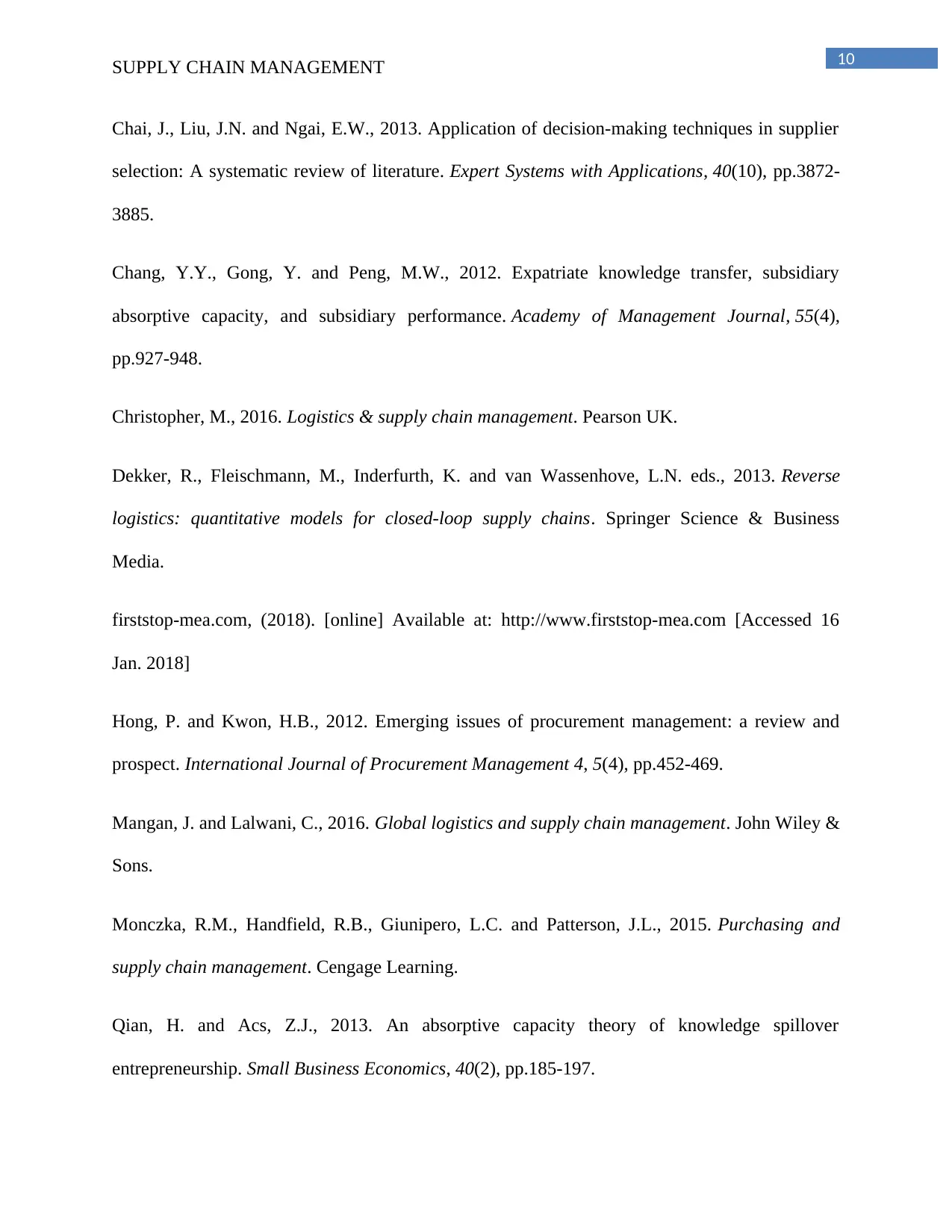
10SUPPLY CHAIN MANAGEMENT
Chai, J., Liu, J.N. and Ngai, E.W., 2013. Application of decision-making techniques in supplier
selection: A systematic review of literature. Expert Systems with Applications, 40(10), pp.3872-
3885.
Chang, Y.Y., Gong, Y. and Peng, M.W., 2012. Expatriate knowledge transfer, subsidiary
absorptive capacity, and subsidiary performance. Academy of Management Journal, 55(4),
pp.927-948.
Christopher, M., 2016. Logistics & supply chain management. Pearson UK.
Dekker, R., Fleischmann, M., Inderfurth, K. and van Wassenhove, L.N. eds., 2013. Reverse
logistics: quantitative models for closed-loop supply chains. Springer Science & Business
Media.
firststop-mea.com, (2018). [online] Available at: http://www.firststop-mea.com [Accessed 16
Jan. 2018]
Hong, P. and Kwon, H.B., 2012. Emerging issues of procurement management: a review and
prospect. International Journal of Procurement Management 4, 5(4), pp.452-469.
Mangan, J. and Lalwani, C., 2016. Global logistics and supply chain management. John Wiley &
Sons.
Monczka, R.M., Handfield, R.B., Giunipero, L.C. and Patterson, J.L., 2015. Purchasing and
supply chain management. Cengage Learning.
Qian, H. and Acs, Z.J., 2013. An absorptive capacity theory of knowledge spillover
entrepreneurship. Small Business Economics, 40(2), pp.185-197.
Chai, J., Liu, J.N. and Ngai, E.W., 2013. Application of decision-making techniques in supplier
selection: A systematic review of literature. Expert Systems with Applications, 40(10), pp.3872-
3885.
Chang, Y.Y., Gong, Y. and Peng, M.W., 2012. Expatriate knowledge transfer, subsidiary
absorptive capacity, and subsidiary performance. Academy of Management Journal, 55(4),
pp.927-948.
Christopher, M., 2016. Logistics & supply chain management. Pearson UK.
Dekker, R., Fleischmann, M., Inderfurth, K. and van Wassenhove, L.N. eds., 2013. Reverse
logistics: quantitative models for closed-loop supply chains. Springer Science & Business
Media.
firststop-mea.com, (2018). [online] Available at: http://www.firststop-mea.com [Accessed 16
Jan. 2018]
Hong, P. and Kwon, H.B., 2012. Emerging issues of procurement management: a review and
prospect. International Journal of Procurement Management 4, 5(4), pp.452-469.
Mangan, J. and Lalwani, C., 2016. Global logistics and supply chain management. John Wiley &
Sons.
Monczka, R.M., Handfield, R.B., Giunipero, L.C. and Patterson, J.L., 2015. Purchasing and
supply chain management. Cengage Learning.
Qian, H. and Acs, Z.J., 2013. An absorptive capacity theory of knowledge spillover
entrepreneurship. Small Business Economics, 40(2), pp.185-197.
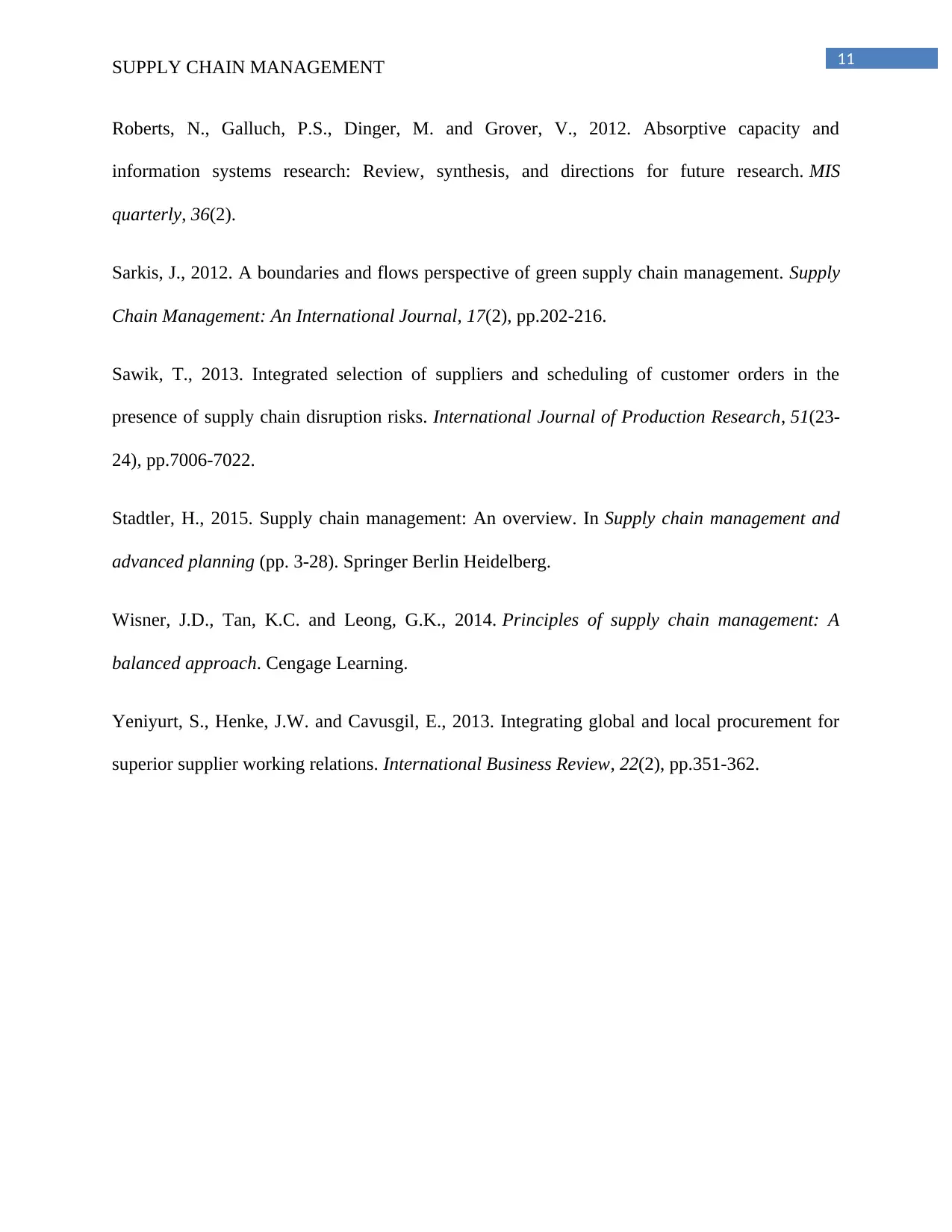
11SUPPLY CHAIN MANAGEMENT
Roberts, N., Galluch, P.S., Dinger, M. and Grover, V., 2012. Absorptive capacity and
information systems research: Review, synthesis, and directions for future research. MIS
quarterly, 36(2).
Sarkis, J., 2012. A boundaries and flows perspective of green supply chain management. Supply
Chain Management: An International Journal, 17(2), pp.202-216.
Sawik, T., 2013. Integrated selection of suppliers and scheduling of customer orders in the
presence of supply chain disruption risks. International Journal of Production Research, 51(23-
24), pp.7006-7022.
Stadtler, H., 2015. Supply chain management: An overview. In Supply chain management and
advanced planning (pp. 3-28). Springer Berlin Heidelberg.
Wisner, J.D., Tan, K.C. and Leong, G.K., 2014. Principles of supply chain management: A
balanced approach. Cengage Learning.
Yeniyurt, S., Henke, J.W. and Cavusgil, E., 2013. Integrating global and local procurement for
superior supplier working relations. International Business Review, 22(2), pp.351-362.
Roberts, N., Galluch, P.S., Dinger, M. and Grover, V., 2012. Absorptive capacity and
information systems research: Review, synthesis, and directions for future research. MIS
quarterly, 36(2).
Sarkis, J., 2012. A boundaries and flows perspective of green supply chain management. Supply
Chain Management: An International Journal, 17(2), pp.202-216.
Sawik, T., 2013. Integrated selection of suppliers and scheduling of customer orders in the
presence of supply chain disruption risks. International Journal of Production Research, 51(23-
24), pp.7006-7022.
Stadtler, H., 2015. Supply chain management: An overview. In Supply chain management and
advanced planning (pp. 3-28). Springer Berlin Heidelberg.
Wisner, J.D., Tan, K.C. and Leong, G.K., 2014. Principles of supply chain management: A
balanced approach. Cengage Learning.
Yeniyurt, S., Henke, J.W. and Cavusgil, E., 2013. Integrating global and local procurement for
superior supplier working relations. International Business Review, 22(2), pp.351-362.
1 out of 12
Related Documents
Your All-in-One AI-Powered Toolkit for Academic Success.
+13062052269
info@desklib.com
Available 24*7 on WhatsApp / Email
![[object Object]](/_next/static/media/star-bottom.7253800d.svg)
Unlock your academic potential
© 2024 | Zucol Services PVT LTD | All rights reserved.





